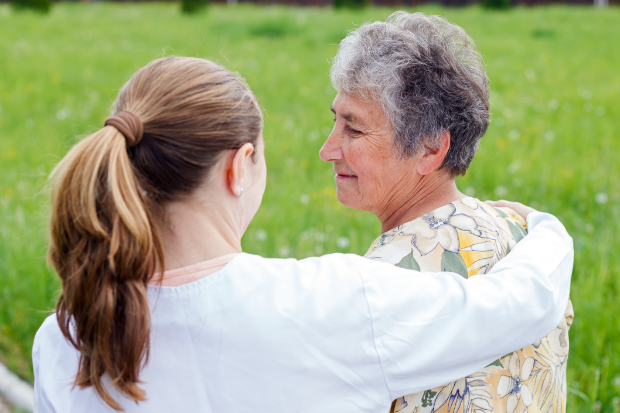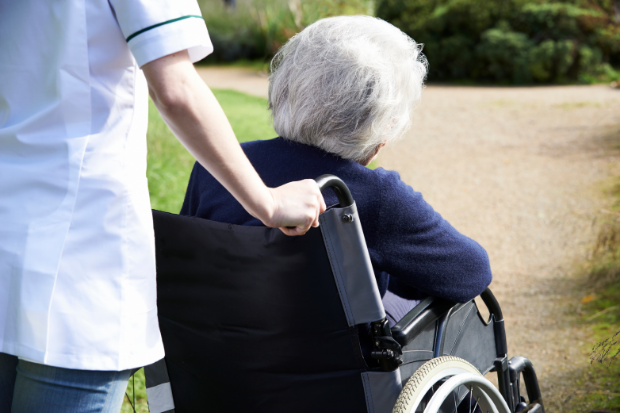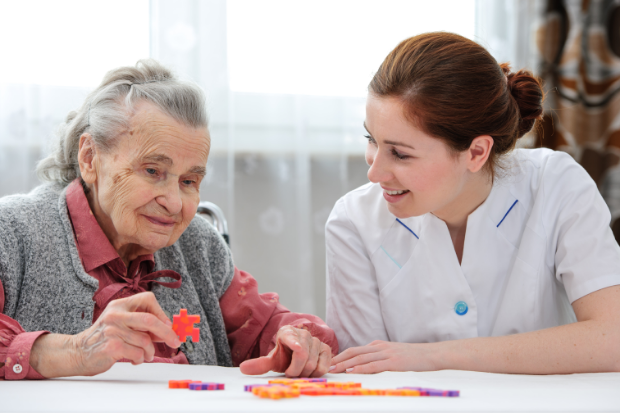A nurse on lockdown in a dementia village

INQUIRER.net stock photo
(Caring for dementia patients in a pandemic: First of two parts)
“Kailan bibisita ‘yung anak ko, ‘yung family ko?”
At the height of the pandemic, Romnick Ramos, a 32-year-old geriatric nurse, would get persistent questions from his patients concerning their families.
Ramos works in La Verna Aged Care and Dementia Village in Marikina City, where he has been staying since July due to the lockdown. As if the pandemic is not enough, they also faced the onslaught of Typhoon Ulysses, which thankfully did not cause any damage to the facility nor any harm to the elderly he nurses.
Older people above 60 years old, along with persons with preexisting medical conditions, are at higher risk of getting severe COVID-19, according to the World Health Organization. The residential facility, thus, had to strictly prohibit visitations when COVID-19 struck to protect its vulnerable residents from being infected and to avoid a possible outbreak within.
Article continues after this advertisementThere are currently about 47 residents in the dementia village, Ramos told INQUIRER.net. Majority of them are long-term residents and are on various stages of dementia, ranging from mild to severe. Those with severe dementia usually can no longer understand their current circumstances and are unaware that the world is in the middle of a pandemic. Those with mild dementia, on the other hand, are still able to comprehend and notice the changes in their surroundings. These patients, he said, are the ones who would often ask about their families.
Article continues after this advertisement“We have to present reality kasi sa kanila po, though ‘yung mga severe dementia po natin hindi naman po nila naiintindihan ‘yung nangyayari sa paligid, pero para sa mga mild dementia po namin, pinapaliwanag na lang po namin ng maayos at ng mabuti…” said Ramos.
(We have to present reality to them, though for severe dementia patients, they [are not aware of] what’s happening. For mild dementia patients, we explain properly and well.)
He added their patients with mild dementia are still able to watch news on TV, so they — the nurses and caregivers — would watch with the patients and explain what is happening around them.
“Para po silang mga bata nga po, so sinasamahan po namin sila manood, pinapaliwanag namin sa kanila ‘yung nangyayari,” he said. “Pag hindi na po angkop ‘yung napapanood nila, kami na po ‘yung nagtu-turn off ng TV, then i-di-divert na lang po namin ‘yung attention nila.”
(They are like children, so we accompany them when they watch TV. We explain to them what is happening. When what they see is no longer appropriate, we’re the ones who turn off the TV then divert their attention away.)
What is dementia?
Dr. Michelle Anlacan, neurologist and president of the Alzheimer’s Disease Association of the Philippines, explained that dementia is the umbrella term used for the syndrome of deteriorating memory, thinking and behavior that is profound enough to impair one’s capacity to perform daily activities.
There are many forms of dementia, the most common of which being Alzheimer’s Disease, which is associated with advanced age. There is also vascular dementia, which occurs after a stroke; fronto-temporal dementia, which is the most common cause for young onset dementia; and Parkinson’s disease dementia, among others, according to Dr. Anlacan.
Dementia is considered as one of the major causes of disability among older people the world over, as per the World Health Organization on Sept. 21. Globally, about 50 million people are afflicted with dementia, with nearly 10 million new cases annually. Majority or nearly 60% also live in low and middle-income countries. The WHO has projected the total number of people with dementia would reach 82 million by 2030 and 152 million by 2050.
When COVID-19 struck, Dr. Anlacan anticipated the challenges the pandemic would have on persons with dementia and their caregivers.
“The patients are intrinsically vulnerable because they are forgetful and unable to understand public health information and reminders,” she told INQUIRER.net. “They forget how to properly wear PPEs and how to wash their hands properly. Social distancing may also be forgotten or ignored.”
The lockdown saw people shut in inside their homes, which posed a challenge to persons with dementia who lived with their immediate families.
“This scenario was meant to protect persons with dementia, but it also restricted them to their homes,” she said. ”A very challenging situation arose as their immediate family cared for them and access to informal caregivers, extended family, friends and recreational activities were stopped completely. Hospitals closed their outpatient services and concentrated their efforts in fighting the surge of severe COVID-19 patients.”

INQUIRER.net stock photo
Burnout and homesickness
There are many sacrifices involved in the work of care. And the struggle in caring for persons with dementia is not just palpable at home, but also for those who work in a residential facility like Ramos.
Even without the pandemic, looking after dementia patients has always been demanding.
“Being a nurse and parang caregiver na rin po, and sure po ako nararamdaman din po ng [coworkers] ko, before pandemic, sobrang hirap po mag-alaga ng isang may dementia kasi po para na po sila mga babies,” he told INQUIRER.net.
(Being a nurse and almost like a caregiver, I am sure that my [coworkers] before the pandemic already feel the great difficulty in caring for someone with dementia, because they are like babies.)
“Ibibigay niyo pong lahat sa kanila, ipo-provide niyo po lahat sa kanila kasi nakakalimutan na po nilang kumain, nakakalimutan na po nilang gamitin ‘yung isang bagay kung para saan ‘yun.”
(You have to hand everything to them, provide everything for them because they already forget to even eat. They forget what a particular thing is for.)
The health crisis has thrust healthcare workers into the frontlines in the battle against COVID-19, which has left many of them exhausted, burned out, and worse, infected with the disease. For Ramos, the pandemic has taken a toll on him mentally and physically. Apart from the exhaustion and burnout from work, healthcare workers like him also have to deal with the hardship of being away from their families for a long time.
“Sobrang hirap po. Sobrang struggle at marami pong sacrifices na ginagawa bilang isang nurse at mga kasama ko pong mga caregivers,” he said. “Hindi po namin nakikita ‘yung family namin, meron pong time na we are burned out [from] the work… Kailangan din po namin ng kalinga ng isang pamilya.”
(It’s so hard. It’s a great struggle and a lot of sacrifices have to be made as a nurse and as caregivers like my colleagues. We don’t see our families. There are times when we are burned out from the work. We also need care from our own families.)

INQUIRER.net stock photo
Dementia care amid COVID-19
Ramos’ job description as a geriatric nurse means he is in charge of administering and preparing medication, as well as administering medical procedures on the residents in the dementia village. But as in healthcare, there are no hard and fast rules when it comes to responsibilities.
Oftentimes, Ramos finds himself covering for the tasks of the caregivers when they find themselves preoccupied in looking after other residents. In the facility, nurses and caregivers collaborate with each other and meet in the middle so they can properly administer care to residents.
“Teamwork po kasi kami dito, so pag kami pong mga nurse, pag hindi naman po kami busy at busy po ‘yung mga caregivers, tumutulong din po kami sa pagpapakain, sa pagpapaligo po, sa pag-a-assist lalo na po sa pagbubuhat,” he said.
(We have teamwork here. For us nurses, if it so happens that we are not that busy while the caregivers are busy, we also help in the feeding, the bathing, and most especially in the lifting of patients.)
They also ensure that the residents follow the safety protocols inside the facility, such as physical distancing and wearing of face masks and face shields, in their daily routines. This may be a bit tricky sometimes when the patients are used to socializing with their peers in the facility, especially among those who have become close friends.
“Meron po kaming mga pasyente mag-be-best friends po dito na daily routine nila is mag-usap, makipagkwentuhan. So dun po kami banda nagkaka-struggle, nahihirapan, but we make sure na pag may ganung situation pinag-we-wear na lang po namin sila ng mask,” he said.
(We have patients who are best friends here and their daily routine is to talk to each other, telling stories. That’s where we struggle but we make sure that in such situations, we ask them to wear masks.)
In place of physical visitations, the residential facility also offered alternative means of communication so families can keep in touch with the residents.
According to Ramos, families were able speak to the residents through video calls and phone calls. They only needed to schedule a session with the management since there were many other families who wanted to call their loved ones in the facility.
The pandemic indeed has seen many people turn to technology not just for socializing but also for seeking healthcare. Dr. Anlacan has said that adapting to technology was necessary during the pandemic since most health checkups shifted to telemedicine. For her, telemedicine seems to be appropriate in dementia evaluation, treatment and care.
“Gone are the days that the family needed to hire a van and take a day off work just to bring a frail wheelchair-bound grandma with dementia for her check-up. Telemedicine is convenient, reliable and cost-effective,” she said. “There may be a small subset of patients, though, that may need face-to-face consultation and this should be readily available.”
The only challenge, it seems, is for families and healthcare workers to be as engaging and malambing (affectionate) online as they are in person, she added.
Today, the dementia village is slowly welcoming visitors back into the facility, said Ramos. Health protocols remain to be followed, such as wearing full PPE, face masks, face shields and observing physical distancing. Thus far — and thank goodness — the facility has not had any COVID-19 confirmed case among its staff or residents, as of writing.
Staff and residents are also required to isolate in a room for 14 days when they return from a hospital appointment, and must take an RT-PCR test before being allowed back into the facility.

INQUIRER.net stock photo
Keeping the faith
If Ramos had anything to say to his fellow frontliners, it was this, “keep the faith.” The uncertainties brought on by COVID-19 almost makes it difficult to imagine a reality where it no longer afflicts much of the world, but Ramos remains hopeful that it would somehow eventually run its course.
“Matatapos din ‘tong pandemic na ‘to. Let’s keep each other safe po and healthy. Lagi lang pong mag-iingat tsaka susundin po natin kung ano po ‘yung tama para makaiwas pong makakuha ng sakit ngayong pandemic.”
(This pandemic will end eventually. Let’s keep each other safe and healthy. Let’s be careful always and follow what’s right to avoid getting sick during this pandemic.)
It sounds fitting coming from someone like Ramos, who, in the past, had his own doubts about his profession, thinking he was not cut out for nursing. But taking his own word, he kept the faith.
“Nursing is a call para sa akin kasi kahit saan po ako magpunta, parang kinakailangan po ako, so pinursue ko po siya,” he said. “I love my job being a nurse. Siguro po dumadaloy po sa dugo ko ang pagiging isang nurse.”
(Nursing is a call for me, because everywhere I go, it seems like I am needed, so I pursued it. I love my job being a nurse. Perhaps it flows through my blood, being a nurse.)
“Hindi ko po siya maipaliwanag, pero dumadaloy po sa sistema ko ‘yung pagiging isang nurse kaya siguro dito ako [nilagay] ni God para mag-serve.”
(I can’t explain it, but being a nurse flows through my system. Maybe that’s why God put me here, so I may serve.) JB
[Editor’s note: While Typhoon Ulysses did not cause them any harm at La Verna despite being situated in Marikina, they remain in need of the usual supplies which can help in caring for the Lolos and Lolas, according to Nurse Romnick, such as diapers, underpads, wipes and powdered milk. Concerned donors wishing to send said supplies as Christmas gifts may reach the facility through telephone no. 277470857 or through its official Facebook page. For sending supply donotions, their full address is: 283 Gen. Ordonez, Marikina Heights, Marikina City.]
RELATED STORIES:
There’s a virus among us: How gaming helps Filipinos bond (and stay sane) amid the pandemic
Aging out: The fate of abandoned Filipino children who don’t get adopted
For more news about the novel coronavirus click here.
What you need to know about Coronavirus.
For more information on COVID-19, call the DOH Hotline: (02) 86517800 local 1149/1150.
The Inquirer Foundation supports our healthcare frontliners and is still accepting cash donations to be deposited at Banco de Oro (BDO) current account #007960018860 or donate through PayMaya using this link.